The Call to Service
Rachel ShteirOctober 13, 2010
そもそも芸者というものについてよくしらない。たぶん、それがほとんど日本人一般の感覚だろう。
ところが、欧米だと、日本といえばgeishaというイメージが強いらしい。異常な関心を示す。
geisha という記号には西洋人の東洋の女性、日本の女性に対する幻想が凝縮されているのかもしれない。
Geisha は外面的には上品で受け身、しかして、その実態は性的に奔放貪欲、というイメージがあるそうな。ところがそうした幻想は、geishaやアジア人女性についてよりも、西洋人男性のの神経症的症状について語るところが大きい、と。
芸者は娼婦と勘違いされている、と。
芸者と娼婦の混同は、ペリーが日本を開国した当時から始まり、そのころから、geisha はその着物の内側に性的に堕落した淫らで怪しさを隠し持った女と同義になった、と。
19世紀末には蝶々婦人のイメージで、”白人”男性とgeishaの悲劇のイメージが登場し、そこでは、Geishaと”白人”がロマンスとともに性的にからみあい、しかし、女性は村八分にされ、捨てられ、子供ができると日本から去っていく。
父親に置き去りにされた現実の多くのアムラジアンをみると作品の中だけの話ではないような気もするが。
1960年代になると、geishaはアメリカ女性と併置されるようになり、そこでは、
アジア女性は、愛の意味を知らず、今度はマドンナによって愛の意味を教えてもらう存在になっている。
また、アジア系アメリカ人によるエムバタフライの、
”白人”は虐げられた東洋の女性という幻想の犠牲になっている、という視点は、”白人”でないアジア系の著者の視線があったからこそ可能であった、と。
ちょっとわかりにくい記事で咀嚼しきれていないが、私は、むしろ、カリスママンの追っかけをする東洋人女性、あるいは”白人”男性の好みの日本・日本人像を選択的に描写する英語圏日本人Geisha記者の心理に興味がある。彼女らの”白人”や欧米に対する幻想を知りたいのだ。
案外、後進的な日本の犠牲になっている自分を救ってくれる白馬にのった騎士、あるいは、知と富と力が凝縮した幻想を伴った”白人”像がそこにあるのかもしれない。
”白人”から東洋人女性、あるいは、逆の方向でも、どちらにせよ、幻想はいずれは幻滅に終わるものであるが、幻滅のあとにさらなる相互理解というのはあり得る。
昨日取り上げた櫻田氏のブログ
October 14, 2010
「柳腰外交」…?
やれ、弱腰だ、柳腰だという、言葉使いについての議論は政治とは関係ないのでどうでもいいのであるが、
とある。
2009年03月13日 6:19 pm JST
「カワイイ大使」参上
かわいい大使というのは英語圏でも紹介されていた。官僚がいいと思ってやったのだろうが、
State-sponsored Cute: Kawaii Ambassadors | JapanNewbie
Posted on 14. Jan, 2010 @ 3:43 am by harvey in Culture, Society
これを通じて日本をはじめて知った者にとっては歪んだ日本像を提供することになろう、と。
コメント欄がおもしろくて、
こうしたカワイイ大使は性的な意味合いを帯びると受け取る人がいるようである。
たしかに、ロリコンと言われるようなポルノの領域があるようであるが、しかし、カワイイ、というのは、子供っぽい故に性的な意味合いが脱色される、というのが大方の日本人の印象ではないか、と思う。
記号(能記)の意味や効果が文化によって違う、という一例ではないだろうか?
可愛い
そういえば、この間散髪したら、70代半ばの女性に、「あら、かわいくなりましたね」と言われた。「もともとです」と答えておいたが可愛いおじさんもいる。かわいいばっちゃんも、じっちゃんもいる。
逆に可愛くない、といえば、敵意を感じさせる、心を和ませない何かを持っている、ということであろう。
いずれにせよ、性的な意味合いを含まないからこそ、性的な意味合いを含ませる場合は、
エロかわいい
という造語(ーーーこの言葉は知らなかったーーー)ができるのであろう。
(ただし、エロは「えらく」=「とても」とのひっかけもあるのかもしれない)
13 October 2010 Last updated at 08:58 GMT Share this pageFacebookTwitterShareEmailPrint
Cheerleading: Why do boys want to wave pop-poms?
By Vanessa Barford
チアリーダーに励むイギリス少年たち。
Rachel ShteirOctober 13, 2010
Yoko Kawaguchi氏の"Butterfly's Sisters"の書評。なぜ芸者は娼婦と誤解されるのか。オリエンタリズム批判のようだけれど評者は不満げ。芸者がなにか書かずに批判だけするのはPC的じゃないかと。
mozu
そもそも芸者というものについてよくしらない。たぶん、それがほとんど日本人一般の感覚だろう。
ところが、欧米だと、日本といえばgeishaというイメージが強いらしい。異常な関心を示す。
geisha という記号には西洋人の東洋の女性、日本の女性に対する幻想が凝縮されているのかもしれない。
But it would surely enrage Kawaguchi who, growing up in America, was “greatly irritated” by stereotypes of the geisha as mincingly passive and sexually voracious. She wrote this book to show that the “dream women that haunt the western imagination” reveal more about the West’s neuroses than about the geisha―and Asian women in general―and that the geisha “reflects changing western anxieties regarding female sexuality in general.”
Geisha は外面的には上品で受け身、しかして、その実態は性的に奔放貪欲、というイメージがあるそうな。ところがそうした幻想は、geishaやアジア人女性についてよりも、西洋人男性のの神経症的症状について語るところが大きい、と。
Butterfly’s Sisters is obsessed with how Western reformers, writers, and artists confuse prostitutes and geishas. The first sections of the book outline how this confusion arose. Initially male entertainers, geishas became an all-female profession in eighteenth-century Imperial Japan, where they were tea house hostesses, proficient in the traditional arts of singing and dancing as well as in conversation and letter-writing. Sometimes the female geishas worked in brothels, amusing customers waiting for prostitutes. Sold into slavery as children, they lived alongside prostitutes in the pleasure quarters walled off from the rest of the city. And some geisha may have actually been prostitutes.
芸者は娼婦と勘違いされている、と。
But the conflation of geishas with prostitutes began in earnest when Commodore Perry opened Japan in 1850, and European and American reformers became obsessed with the geisha’s morality and sexuality: was she synonymous with chastity, or did a sexually depraved Amazon lurk beneath those kimono folds? Many Westerners suspected the latter, because Japanese women laughed about sex, men and women bathed together apparently without shame, and the government regulated brothels when it should have banned them.
芸者と娼婦の混同は、ペリーが日本を開国した当時から始まり、そのころから、geisha はその着物の内側に性的に堕落した淫らで怪しさを隠し持った女と同義になった、と。
By the end of the nineteenth century, European writers drifted from an obsession with geishas’ morality and sexuality to the tragic liaisons between them and Western men, the most important example of which is Madame Butterfly. The stories Kawaguchi tells about how in real life it was European and American men who demanded Butterfly-type liaisons (as opposed to Japanese women entrapping them) are unsettling. Many of the proto-Butterflies who became romantically and sexually involved with these men were ostracized and then abandoned. If children appeared, they did not stay in Japan.
19世紀末には蝶々婦人のイメージで、”白人”男性とgeishaの悲劇のイメージが登場し、そこでは、Geishaと”白人”がロマンスとともに性的にからみあい、しかし、女性は村八分にされ、捨てられ、子供ができると日本から去っていく。
父親に置き去りにされた現実の多くのアムラジアンをみると作品の中だけの話ではないような気もするが。
But since the 1960s, Hollywood and pop stars have “juxtaposed the geisha with strong American women” she writes.
1960年代になると、geishaはアメリカ女性と併置されるようになり、そこでは、
“Asians, as though ignorant of the meaning of love, yet again have to be taught about love, this time by Madonna.”
アジア女性は、愛の意味を知らず、今度はマドンナによって愛の意味を教えてもらう存在になっている。
また、アジア系アメリカ人によるエムバタフライの、
“The white man becomes the victim of his fantasy of the victimized oriental woman.”
”白人”は虐げられた東洋の女性という幻想の犠牲になっている、という視点は、”白人”でないアジア系の著者の視線があったからこそ可能であった、と。
ちょっとわかりにくい記事で咀嚼しきれていないが、私は、むしろ、カリスママンの追っかけをする東洋人女性、あるいは”白人”男性の好みの日本・日本人像を選択的に描写する英語圏日本人Geisha記者の心理に興味がある。彼女らの”白人”や欧米に対する幻想を知りたいのだ。
案外、後進的な日本の犠牲になっている自分を救ってくれる白馬にのった騎士、あるいは、知と富と力が凝縮した幻想を伴った”白人”像がそこにあるのかもしれない。
”白人”から東洋人女性、あるいは、逆の方向でも、どちらにせよ、幻想はいずれは幻滅に終わるものであるが、幻滅のあとにさらなる相互理解というのはあり得る。
昨日取り上げた櫻田氏のブログ
October 14, 2010
「柳腰外交」…?
やれ、弱腰だ、柳腰だという、言葉使いについての議論は政治とは関係ないのでどうでもいいのであるが、
日本は、「柳腰外交」を昔から延々とやってきた。
近年では、「カワイイ大使」であろう。仙谷長官は、気づいていたか。
とある。
2009年03月13日 6:19 pm JST
「カワイイ大使」参上
かわいい大使というのは英語圏でも紹介されていた。官僚がいいと思ってやったのだろうが、
State-sponsored Cute: Kawaii Ambassadors | JapanNewbie
Posted on 14. Jan, 2010 @ 3:43 am by harvey in Culture, Society
For those people whose first interaction with Japan or Japanese people are the Cute Ambassadors, I would imagine that their view of Japan would become strangely skewed as a result.
これを通じて日本をはじめて知った者にとっては歪んだ日本像を提供することになろう、と。
コメント欄がおもしろくて、
In that dress i can imagine what kind of “good” will she’ll be cultivating. I don’t know why Japan can’t see this “cute” lolita/ Schoolgirl/ French maid Cosplay pop culture for what it is: Sexual enticement.
if you say so…everyone is entitled. But grown women dressing up like little girls is a sexual idea that appeals to…lets just say many men, and not only japanese men but the world over. It dominates the porn which is the biggest industry here so it aint just me that sees it that way…
こうしたカワイイ大使は性的な意味合いを帯びると受け取る人がいるようである。
たしかに、ロリコンと言われるようなポルノの領域があるようであるが、しかし、カワイイ、というのは、子供っぽい故に性的な意味合いが脱色される、というのが大方の日本人の印象ではないか、と思う。
記号(能記)の意味や効果が文化によって違う、という一例ではないだろうか?
可愛い
・・・・・何らかの意味で「愛すべし」と感じられる場合に用いられる・・・・・目上の高齢者や成人男性、場合によっては、神仏の像や天皇に対して使用される例も散見される
これは「愛すべき」対象の適用範囲が、単なる外見にとどまらず性格やイメージに関してまで広がったことにより、対象に対して敵意を抱く要素や威圧的な要素がなく、自身の心を和ませる美点をもつと判断された場合に使われるようになったことによる
そういえば、この間散髪したら、70代半ばの女性に、「あら、かわいくなりましたね」と言われた。「もともとです」と答えておいたが可愛いおじさんもいる。かわいいばっちゃんも、じっちゃんもいる。
逆に可愛くない、といえば、敵意を感じさせる、心を和ませない何かを持っている、ということであろう。
いずれにせよ、性的な意味合いを含まないからこそ、性的な意味合いを含ませる場合は、
エロかわいい
という造語(ーーーこの言葉は知らなかったーーー)ができるのであろう。
(ただし、エロは「えらく」=「とても」とのひっかけもあるのかもしれない)
13 October 2010 Last updated at 08:58 GMT Share this pageFacebookTwitterShareEmailPrint
Cheerleading: Why do boys want to wave pop-poms?
By Vanessa Barford
チアリーダーに励むイギリス少年たち。



















